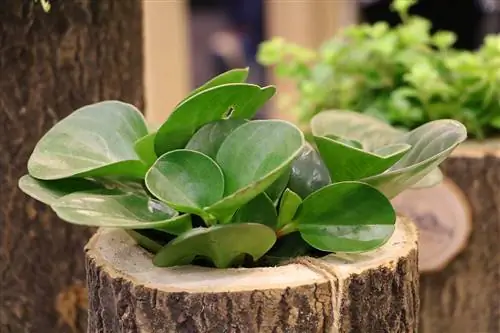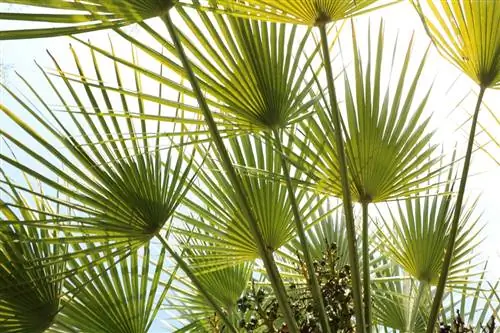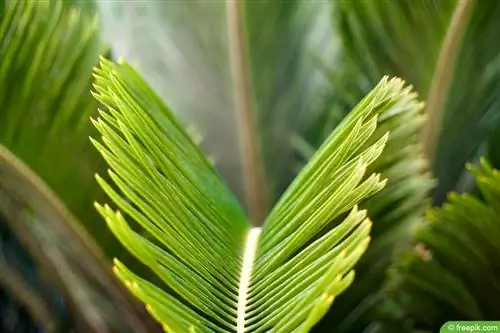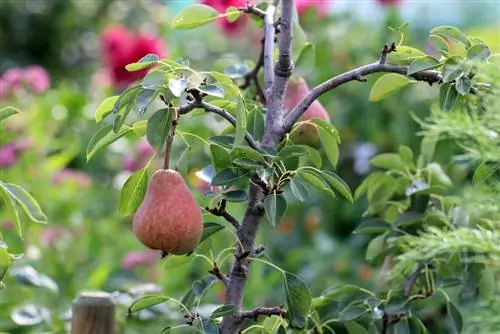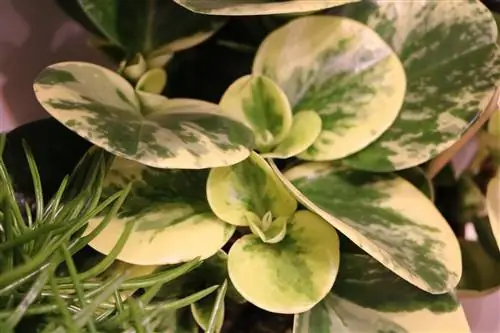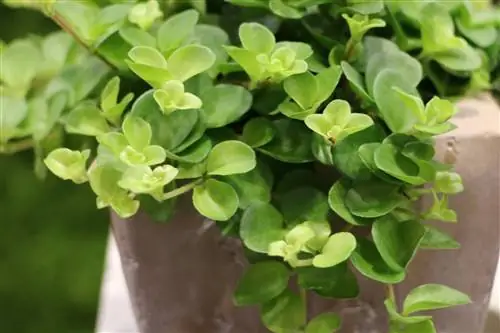- Author admin [email protected].
- Public 2023-12-17 03:39.
- Last modified 2025-01-24 12:45.
Peperomia obtusifolia is available in a wide variety of leaf colors: pure green leaves, with yellow-green foliage or white-green spotted or striped variants, some of which have a red border. The growth forms also differ slightly. Some dwarf peppers grow strictly upright, others spread more in a creeping manner, while others with their slightly drooping shoots are perfect for use as hanging plants. Although the herbaceous plant is quite robust, it does place certain demands on its watering. Only with the right watering behavior can peperomia thrive and be an enrichment for the hobby gardener.
Short profile
- Botanical name: Peperomia obtusifolia
- other names: peperomia, pepper face, ornamental pepper, fleshy peperomia, magnolia-leaved pepper face
- belongs to the pepper plant genus (Piperaceae)
- evergreen, herbaceous plant
- Leaves: fleshy, shiny, usually elliptical shape with blunt tip
- Shoots are often purple
- whitish flower spadix between early summer and autumn
- Growth height: about 15 to 30 cm
Varieties and occurrences
The dwarf pepper, botanically Peperomia, belongs to the pepper family and, with over 1,500 species, is widespread almost everywhere in the tropical regions of the world. Most Peperomia species grow as perennial herbaceous plants of varying size and appearance as epiphytes on larger trees, some also terrestrially. Most ornamental peppers are native to the rain or cloud forests of Central America. Some dwarf pepper species can store water and are therefore succulent plants. One of the best known and most popular types of dwarf pepper is Peperomia obtusifolia, also called fleshy peperomia. This species impresses with its blunt, round, fleshy leaves; there are varieties with green or colored leaves.
- Peperomia obtusifolia 'Alba': young leaves in light lemon yellow, later turning a little darker
- Peperomia obtusifolia 'Albo marginata': grey-green leaves with silvery white edges
- Peperomia obtusifolia 'Greengold': cream-colored spots on gray-green leaves
- Peperomia obtusifolia 'Variegata': light yellow or cream colored bands on green foliage
- Peperomia obtusifolia 'Minima': Dwarf form with leaves only 3 cm in size
Location
The location for a fleshy dwarf pepper should be as bright as possible, but not in full sun. Since the distinctive foliage plant comes in many different leaf colors, the rule applies here: the more colorful the foliage is, the brighter the plant should be. Green varieties do not tolerate quite as much sun as variegated Peperomia varieties. In summer, the ornamental pepper can be placed outside on the terrace or balcony as an alternative to its usual place in the apartment. The condition for this is that the temperatures no longer fall significantly below 15 degrees (especially at night) and that it has a place protected from the midday sun. All peperomias require a warm climate all year round and cannot tolerate cold temperatures.
- Light requirements: sunny to very light partial shade
- no direct midday sun in summer
- Temperature: 18 to 24 degrees
- does not tolerate strong temperature fluctuations
- free from drafts
- preferably high humidity
- red-leaved varieties also on the shaded south window
- green-leaved varieties better on the east or west window
Pouring
Peperomias do not tolerate wet roots because most species grow epiphytically and therefore do not have a developed root system as they do not have permanent access to the water in the soil. Their stems or leaves are more or less juicy or fleshy to prevent the substrate from drying out. Waterlogging causes signs of rot in a short period of time. Watering too intensively is one of the most common care mistakes and is the cause of plants dying. That's why the dwarf pepper is regularly watered with a little water, about once a week is usually enough. Alternatively, the plant can also be watered thoroughly every two to three weeks. It is important to remove any excess water from the saucer after five minutes. The substrate should always be able to dry out well between the individual watering intervals.
Tip:
It's best to pour the water into the saucer so that the leaves don't get wet.
Fertilize
The Peperomia obtusifolia is fertilized regularly every three to four weeks during the growing season between April and August with commercially available green plant fertilizer in a weakly concentrated form via the irrigation water. Too many nutrients cause soft and unnatural growth. Often the result is that the plant no longer has sufficient stability and the tissue collapses.
Substrate/Repotting
The substrate for the dwarf pepper should be well permeable to air and water. Since the plants do not have a developed root system, relatively small planters are sufficient. That's why the Peperomia rarely needs to be repotted. It is best to carefully pull the pepper face out of the plant pot every spring and examine the root growth. If the soil is not yet visibly rooted, no repotting is necessary. Only when roots are visible on the outside of the ball does the plant need a slightly larger container and more substrate. The dwarf pepper should be watered before repotting. Then the fresh substrate bonds better with the root ball. Peperomia obtusifolia gets along well with shallow bowls or hanging baskets.
- 3 parts commercial potting soil
- Part sand
- 1 part peat soil
- 1 part grit, lava granules or fine expanded clay granules
- alternatively commercially available cactus soil with peat moss
- first fill in a drainage layer
The larger the pot for the pepper face, the coarser the grain of the substrate should be to ensure good permeability for air and water. For vessel diameters of over 15 cm, it makes sense to add coarse lava rock, expanded clay or even some orchid substrate (coarse bark).
Tip:
If the pepper face doesn't grow well despite regular watering, it's probably not getting enough air to the roots. A coarser substrate can help.
Care
The dwarf pepper is not particularly maintenance-intensive. Some varieties prefer high humidity, which is why the herbaceous plants appreciate occasional spraying with room temperature, soft water. However, this is usually only necessary in the winter months when the heating dries out the air.
Tip:
The leaves of the slightly succulent plant have stomata on the top. Leaf shine spray clogs these openings, causing the leaves to turn black.
Cutting
The dwarf pepper is one of the “easy care” plants that requires little care. The fleshy plant does not need to be cut regularly. Wilted leaves or inflorescences should be removed regularly. No tools are usually necessary as the juicy stems can be easily broken out by hand. If the pepper face becomes too big for the windowsill, it can be cut back in spring.
- cut the ends of the shoots
- remove side shoots
- take out all sick or wilted leaves and flowers
Propagate
Although some species of pepper face (especially the annual varieties) propagate by seeds, the usual procedure is vegetative propagation by cuttings. There are about a dozen varieties of Peperomia obtusifolia that are cultivated as houseplants. These can be easily divided into two groups: variegated varieties and unvaried varieties.
Head cuttings
Modified cultivars are propagated by head cuttings, as they lose their special characteristics through leaf cuttings. One of the most common variegated varieties is Peperomia magnoliifolia, which, according to the latest teachings, also belongs to the fleshy peperomias. There are also varieties with red-yellow edged or creamy white variegated leaves. Purely green varieties can also be propagated via head cuttings.
- Time: Spring or early summer
- Select shoot tip with good color development
- Length: at least two pairs of leaves and growing tip (about 7 cm)
- remove lower pair of leaves
- Cut the shoot just below the lower eye
- (below the removed leaves)
- use a sharp, clean knife
- Substrate: Mixture of peat or peat moss, sand and perlite
- Pot size: maximum 9 cm
- alternative plant bowl
- Planting distance (in bowls): at least 3 cm
- make a hole in the substrate with a wooden skewer or pen
- Insert cuttings
- Depth: maximum to just below the first pair of leaves
- Press the soil lightly
- just pour lightly
- Place plant pot in clear plastic bag
- support with wooden skewers if necessary
- Temperature: around 18 degrees
- no direct sun
- alternatively, first root in a glass with water
In summer, the cutting is placed in a warm, bright place in the room to root. Direct sunlight must be avoided at all costs. In the winter months, it is a good idea to place the plant bowl on a windowsill above the heater, as the soil should be nice and warm for the roots to develop. If the young plants show the first signs of growth after about five weeks and new leaves form, they may be separated into 9 cm pots and cared for like adult specimens.
Leaf cuttings
Unmodified varieties (i.e. green-leaved species) can also be propagated using leaf cuttings. To do this, a he althy, strong leaf is cut as low as possible on the shoot without unduly injuring the shoot itself. This works best with a clean razor blade.
- Substrate: cactus soil, growing soil or mixture of peat and sand
- Press the leaf with the stem lightly into the soil
- Keep soil only slightly moist
- wet substrate causes the leaves to rot
- put in a clear plastic bag for the first two weeks
- set up warm and bright
- no direct sun
As soon as small plants have formed on the edge of the leaves that are sufficiently rooted, they can be separated and planted in loose substrate. Since Peperomia obtusifolia does not form a pronounced root system, relatively small planters are sufficient. It is important to fill in a drainage layer right at the beginning so that no waterlogging occurs.
Wintering
The dwarf pepper is an evergreen plant that usually does not go into winter rest. Therefore, the care does not differ significantly from that in the other months. Even in the cold season, temperatures should not fall below 18 degrees, otherwise there is a risk of cold damage. Due to the lack of light, the plant grows significantly slower from mid-November onwards. Fertilization is stopped from September and only slowly started again in April. The amount of irrigation water is also slightly reduced.
Diseases and pests
Parasites rarely occur on the Fleshy Peperomia. The main causes of plant illness and death are fungi, bacteria or viruses caused by excessive amounts of water, as well as rotting of the plant due to waterlogging.
- Fight scale insects with soap-spirit lye
- Wash off spider mites in the shower
- fading leaves: usually caused by excessive sunlight
- Inhibited growth and wilted appearance: several possible causes. Occurs when the plant is too cold, has been watered too much or the substrate has poor air permeability
- lower leaves become lighter: usually nutrient deficiency of nitrogen or potassium
- Plant loses leaves: often a sign of too much fertilizer, fresh soil is necessary
- Spots on the leaves: overwatering or water on the leaves
If you suspect that the roots are rotting due to overwatering, the plant should be removed from the container over newspaper and the soil shaken off. If the roots are not yet visible, they can be carefully removed from any remaining soil under the shower. This makes it easier to determine which root parts are dead or rotten. Cut off all diseased or wilted parts of the plant and place the he althy parts of the peperomia in fresh, coarse-grained substrate. As a rule, the dwarf pepper grows strongly again within a short time.
Conclusion
The dwarf pepper is one of the easy-care plant species that is ideal for beginners or gardeners who tend to forget their plants. Peparomia obtusifolia forgives the occasional care mistake as long as it is not kept too wet. Waterlogging is one of the care errors that mean the certain death of the plant.

